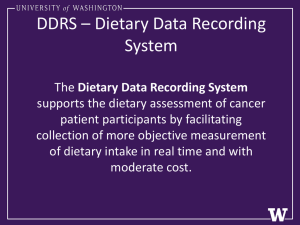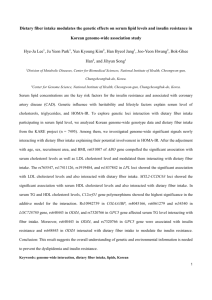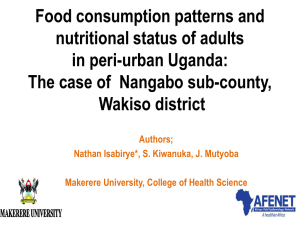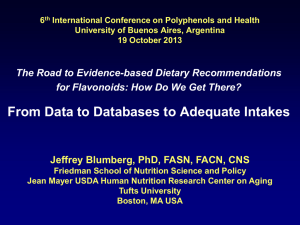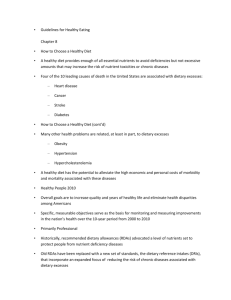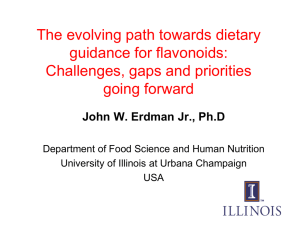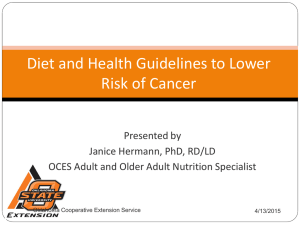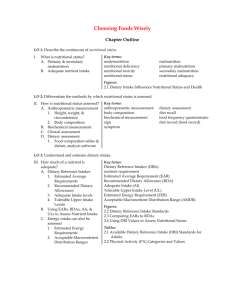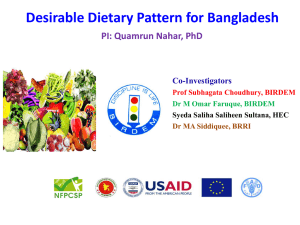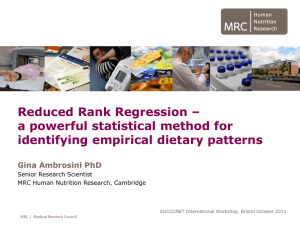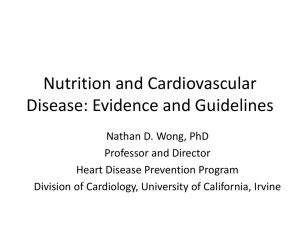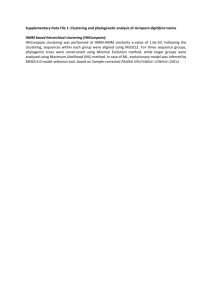Health-Based Tolerable Daily Intakes
advertisement
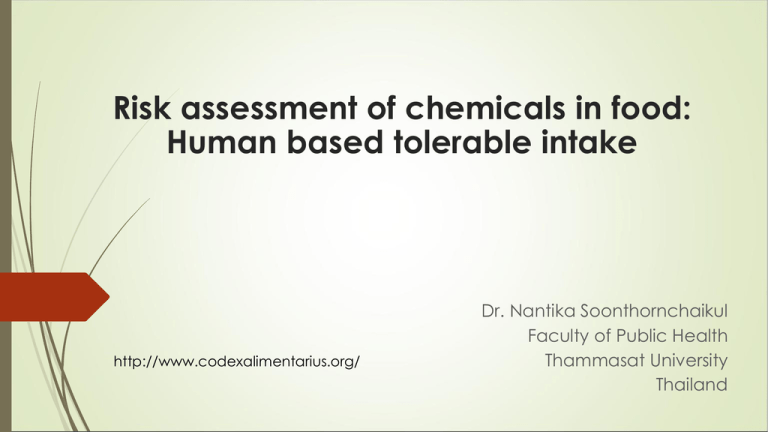
Risk assessment of chemicals in food: Human based tolerable intake http://www.codexalimentarius.org/ Dr. Nantika Soonthornchaikul Faculty of Public Health Thammasat University Thailand เราได้ขอ้ คิดอะไรจากการ ประเมินความเสีย่ งด้วยค่า - HQ และ - Cancer risk ่ เราค ่ สิงที านวณได้คอ ื คาตอบสุดท้ายหรือไม่ ่ มีวธ ิ ป ี ระเมินแบบอืนหรื อไม่ สาหร ับสารเคมีปนเปื ้ อนในอาหาร Chemical risks in food Industrial chemicals 1. การปนเปื้ อน Agricultural chemicals food manufacturing and processing Household chemicals veterinary drug residues others 2. ตัง้ ใจใส่ลงไป ไม่อนุ ญาต ควบคุม Food additive intake (JECFA) Contaminants Pesticides (JMPR) Veterinary drugs pollutants Safe levels of intake Acceptable daily intake : ADI, ARfD Tolerable intake Food additives Contaminants Tolerable daily intake (TDI) Provisional tolerable weekly intake (PTWI) การประเมินความเสีย่ ง คำนวณค่ำ Dietary exposure เปรียบเทียบกับค่ำ Safety level Ci = concentration of chemical in food item (µg/g) Fi = food consumption (g/day) BW = Body weight (kg) US EPA Codex ปริมำณทีบ่ ริโภค (Food consumption) ควำมเข ้มข ้นของสำรเคมีทป่ี นเปื้ อนในอำหำร/นำ้ ดืม่ นำ้ หนักตัว HQ Cancer risk ADI,ARfD PTWI ข้อแนะนาสาหรับ Dietary exposure assessment ต่างจาก Dietary intake Toxicology endpoint, type of chemical, possible population subgroups, data used ถ ้าจะใช ้ค่า International dietary exposure ค่านั้นต ้องเท่ากับหรือสูง กว่าค่า National level ควรใช ้ Consumption data และ concentration ของประเทศตนเอง 1. Acceptable daily intake (ADI) generally estimated by dividing the no-observed-effect level (NOEL) expressed in mg additive per kg (mg/kg) body weight of humans. To protect against the most sensitive adverse effect, it also protects against other adverse effects • Toxicity studies in animals • NOAEL (mg/kg/day) x uncertainty factor •ADI (mg/kg) ตัวอย่าง Chlopyrifos ADI 0–0.01 mg/kg bw ARfD 0.1 mg/kg bw 2. Acute reference dose (ARfD) ้ ม ่ ปริมาณสารปนเปื ้ อนในอาหารและนาดื ้ ต่อนาหนั กตัว ่ ระยะเวลาไม่เกิน 24 ชัวโมง หน่ วย mg/kg BW 3.Tolerable Daily Intakes (TDI) the total intakes by ingestion, to which it is believed that a person can be exposed daily over a lifetime without deleterious effect. They are based on non-carcinogenic effects. expressed on a body weight basis (e.g., mg/kg/day) 4. Provisional tolerable weekly intake (PTWI) Expressed on a weekly basis to emphasize that longterm exposure is important (for contaminants that cumulate in the body) Provides a “bright line” for the risk manager against which intake can be compared Adverse effects are seen with many contaminants in the range of exposure for some population groups difficult to separate risk assessment from risk management Ex: Methyl mercury =1.6 mcg/kg/wk คาถาม การได ้มาซึง่ safety levels ผลการคานวณมีความเป็ นไปได ้ในเชิงปฏิบต ั ห ิ รือไม่ ่ โภคสะท ้อนความเป็ นจริงหรือไม่ ข ้อมูลปริมาณอาหารทีบริ อาหารปนเปื ้อนด ้วยสารเคมีมากกว่า 1 ชนิ ด ได ้ร ับสัมผัส มากกว่า 1 ช่องทาง และสามารถออกฤทธิต่์ ออวัยวะตาแหน่ ง เดียวกัน.............. ปริมาณรวม ???? Aggregate exposure ความรุนแรง???? cummulative exposure ข ้อมูลการบริโภค.....ใช ้ อันไหนดี Potential uses of food consumption surveys Nutrient adequacy estimation Food insecurity Diet-disease relationships Food consumption surveys Exposure assessment Food pattern analysis Additional indicators e.g. : - anthropometry - health indicators Dietary Assessment data types FFQ 24-hour recall Duplicate diet Food records Diet history Dietary vs. exposure assessment Dietary assessment Exposure assessment Purpose To determine -nutritional adequacy - dietary-disease relationship - RDI - dietary guidelines - population groups at risk - basis of nutrition policies and programmes, incl. fortification To determine - if dietary exposure is below toxicological thresholds - main contributing foods or food group(s) - population groups at risk -basis for risk managers to take action -basis of national regulatory and food control systems Data needed - food consumption/supply data - food composition data - food consumption/supply data - occurrence data Formula I = ∑(W1C1 + W2C2 +...WnCn)i where: I = intake of the nutrient, W1 = weight consumed of food 1, C1 = content of the nutrient in food 1, i=individual E = ∑(W1C1 + W2C2 +.... WnCn)i where: E = Dietary exposure, W1 = weight consumed of food 1, C1 = content of the e.g. contaminant in food 1, i=individual Dietary vs. exposure assessment Dietary assessment Exposure assessment Expressed in g/mg/mcg per d g/mg/mcg per d/week/month per kg bodyweight Compared to RDI, UL MPL, ML, ADI Concern < RDI or >UL > MPL/ML/ADI Special methodology Total diet Studies (TDS): selection of foods based on food consumption survey data representing a large portion of a typical diet, preparation of food as consumed and pooling of related foods into distinct food groups before analysis. Model diets: screening methods to assess if ‘worse case scenarios’ are still under toxicological thresholds, e.g. budget method, model diet for veterinary drug residues: 500 g meat: (300g muscle, 100g liver, 50g kidney, ตัวอย่าง พบข้ำวปนเปื้ อนแคดเมีย่ ม 2 ไมโครกรัม/กรัม บริโภคข้ำวเฉลีย่ วันละ 500 กรัม/วัน, สัปดำห์ละ 5 วัน นำ้ หนักตัวเฉลีย่ 60 กก ค่ำ PTWI Cd = 1ไมโครกรัม/กก/สัปดำห์
